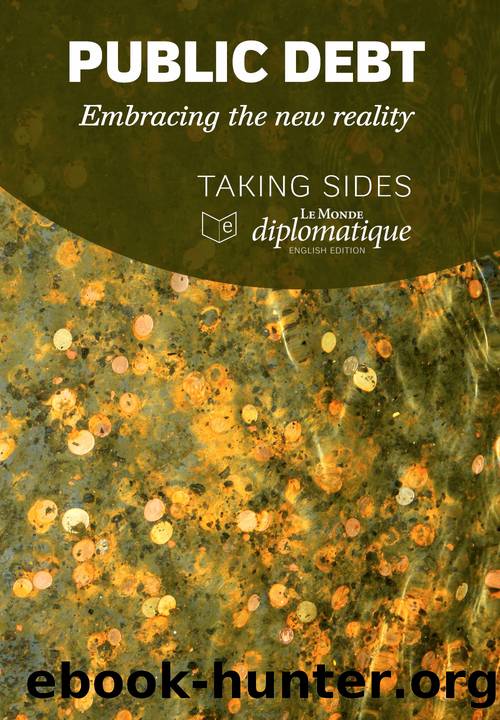Public debt: embracing the new reality by Le Monde diplomatique

Author:Le Monde diplomatique
Language: fra
Format: epub
Publisher: Le Monde diplomatique
Published: 2020-09-09T00:00:00+00:00
Rafael Correa
Rafael Correa is an economist and was president of Ecuador from 2007 to 2017.
Le Monde diplomatique â Public debt: embracing the new reality
Primary surpluses and cheaper credit
Africa borrows on the open market
The decades when the continent couldnât raise major funds on ordinary commercial markets are over, but there are still worries about over-indebtedness.
Sanou Mbaye,June 2015
The nations of sub-Saharan Africa, in the post-independence euphoria of the 1960s, wanted to end the international division of labour under which they exported raw materials and imported manufactured goods. They diversified their economies through industrialisation and improved production capacity, but soon encountered the problem that none (except for South Africa and Rhodesia, now Zimbabwe, both then governed by a white minority) could access international capital markets without the credit rating agenciesâ approval. They could only use private funds guaranteed by states, bilateral funds lent by the Paris Club (1), and multilateral funds from the IMF, World Bank and African Development Bank (AfDB).At the same time, much-needed export revenue was shrinking, mainly because of a global fall in agricultural commodity prices (the index went from 155 in 1977 to 94 in 2002), while the cost of Africaâs imports climbed. In 1979 a rise in US interest rates â a unilateral decision to halt the depreciation of the dollar â significantly worsened Africaâs debt burden.
To improve their finances, African nations turned to international institutions, which dispensed their âdeadly medicineâ, imposing development and structural adjustment programmes, financial deregulation, free trade, privatisation, and wage and budget cuts. These programmes proliferated, all prescribing the same neoliberal, free trade mix.
Under the Heavily Indebted Poor Countries initiative (HIPC), launched in 1996, 36 countries (30 in Africa) benefited from debt relief of $76bn on bilateral and multilateral debt. According to the Committee for the Abolition of Third World Debt (CADTM) these measures are window-dressing: sub-Saharan Africaâs outstanding debt rose from $2bn in 1970 to $331bn in 2012. Over the same period, repayments totalled $435bn, four times the capital borrowed (2).
Download
This site does not store any files on its server. We only index and link to content provided by other sites. Please contact the content providers to delete copyright contents if any and email us, we'll remove relevant links or contents immediately.
| Accounting | Economics |
| Exports & Imports | Foreign Exchange |
| Global Marketing | Globalization |
| Islamic Banking & Finance |
50 Economics Classics by Tom Butler-Bowdon(2082)
Six Billion Shoppers by Porter Erisman(2014)
Why Nations Fail: The Origins of Power, Prosperity, and Poverty by Daron Acemoglu & James Robinson(1805)
No Time to Say Goodbye(1777)
The Economist [T6, 22 Thg9 2017] by The Economist(1661)
Red Notice by Bill Browder(1614)
Currency Trading For Dummies by Brian Dolan(1566)
Thank You for Being Late by Thomas L. Friedman(1468)
Bitcoin: The Ultimate Guide to the World of Bitcoin, Bitcoin Mining, Bitcoin Investing, Blockchain Technology, Cryptocurrency (2nd Edition) by Ikuya Takashima(1433)
Amazon FBA: Amazon FBA Blackbook: Everything You Need To Know to Start Your Amazon Business Empire (Amazon Empire, FBA Mastery) by John Fisher(1316)
Coffee: From Bean to Barista by Robert W. Thurston(1199)
The Great Economists by Linda Yueh(1197)
The Future Is Asian by Parag Khanna(1187)
Pocket World in Figures 2018 by The Economist(1165)
Capitalism Without Capital: The Rise of the Intangible Economy by Jonathan Haskel(1139)
Grave New World by Stephen D. King(1121)
How Money Got Free: Bitcoin and the Fight for the Future of Finance by Brian Patrick Eha(1119)
The Sex Business by Economist(1098)
Cultural Intelligence by David C. Thomas(1023)
